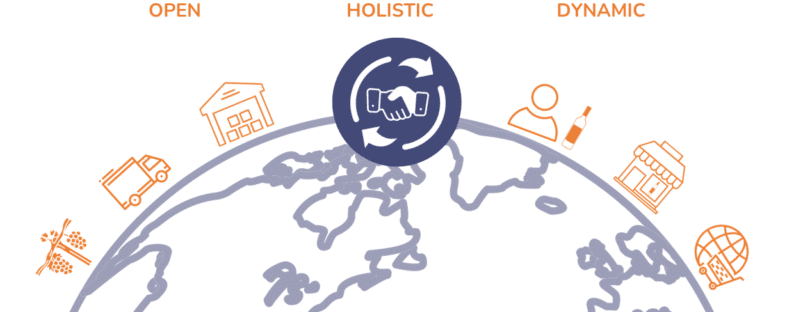Let’s envision the potential landscape of the future wine industry
We know that businesses that cooperate can create a widespread economic benefit by creating a level or beneficial playing field. We also know that the wine market is by nature collaborative, exhibited through the B2B activity that permeates it.
An ecosystem is a self-supporting environment that provides everything that its constituents need. In business terms it consists of sources of supply; access to markets such that demand can be better satisfied with supply; mechanisms for self-reliance and the development of symbiotic relationships; with the means to operate freely and effectively.
An ecosystem is open, holistic and dynamic.
“Ecosystems cannot be entirely planned and designed; they emerge organically and continuously evolve. This adaptability is one of their major strengths. Rather than just being hyper-competitive, successful ecosystem players develop novel ways to compete: they use collaboration as a source of competitive advantage, which allows them to reduce asset ownership and instead use the resources of others.” (Boston Consulting Group 2023)
Open
To realise these benefits an ecosystem must therefore be open, welcoming in-demand services by suppliers who are prepared to integrate into its workflow management. There needs to be a clear value proposition for suppliers of services into the ecosystem, yet with a focus on how each participation improves the potential of primary business constituents. A possible inhibitor could be the relative lack of technical competency within the wine sector.
Holistic
A holistic ecosystem implies interconnectivity, meaning that channels of distribution, sales and marketing are easier to access, and that supply chain operates more efficiently (to the extent that externalities allow), including regulatory specifics like import duties obligations. In the new world of less integrated supply chains, and where stability can’t be taken for granted as it was in the preceding 20-30 years, there’s an opportunity for an ecosystem to provide the basis of greater stability and risk mitigation for participants.
Dynamic
Healthy ecosystems evolve, and a wine business ecosystem must be dynamic, both in participation and operation. Participants might include producers, channel suppliers, merchants/ retailers and brokers, and complementors. Best practice is an important aspect of an ecosystem, since you need standardised processes and rules that participants buy into because they work well and don’t cause operational friction that otherwise wouldn’t exist. Modularisation is a key aspect of a future wine business ecosystem so that constituents across different market segments can choose which components make sense for them according to what they do and their chosen business operating model. For example, agencies and importers have rather different requirements and interests in participation compared to merchants or retailers. Many of those components will have been designed independently yet will be functioning within integrated workflows.
What effect might the ecosystem of the future have on the wine market more generally?
The wine market is intrinsically fragmented, and whilst the broader digitalisation narrative tends to theorise towards market consolidation and a squeeze on margins that reflect the (lowering) marginal costs of distribution and service, it may well not turn out like that.
An ecosystem may in actual fact have the reverse effect of lowering the (already very low) barriers to entry, encouraging more specialisation and increased numbers of market entrants.
An ecosystem could help the range of trade-off decisions businesses make around margin versus flow, given the symbiotic nature of stockholders and low inventory operators, working capital options and widening addressable markets.
The diversity of wine, its vast range of products, the very dynamic production landscape and inherent complexity, represent significant barriers to the idea that the market will inexorably move towards greater consolidation. AI will provide preference and selection assistance in mainstream consumer settings, yet customer service will remain an enduring need, with operational efficiency gains providing scope for delivering better service through to point of delivery.
The future wine industry ecosystem will encourage proliferation of channels to market. Whereas Vivino, Cellar & Co, Drizzly and Studio Beverage Group are among a limited number of consumer facing (multivendor) marketplace models, the aggregation of a significant number of independents supplying those platforms is likely to spawn new ones which tap into different addressable audiences rather more effectively than the current choices (most of which are any case limited geographically) or which simply offer something a bit different.
As marketplaces proliferate, pricing is likely to become more value driven due to competition, which in turn would lend support to stockholder margins and increase participation.
Whereas wine market growth has flattened with competition from new alcoholic beverage categories, it will pick up again over the next few years as Gen Z figure out wine is the healthiest, most convivial and aesthetic choice.
A widespread desire among business owners to reset their wine operations to be competitive for the next 20 years; to take advantage of new market opportunities that digitisation presents; and a sector-wide instinct in favour of cooperation suggest that a wine industry ecosystem could well suit a significant number of SME market participants and play a part in the future of the wine industry.
